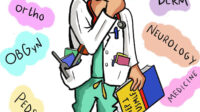Last year, an estimated 86.3 million Americans used a handheld health or fitness app to track daily activity, heart rate and nutrition.
Now, just as we reach for that cookie or carrot, imagine if our apps could audit the efficacy or quality of our real-time activities and health choices—then compare those choices or decisions with those of professional athletes or clinical dietitians? Or imagine if our apps gave expert or Olympic-athlete feedback and coaching—all while we’re actually jogging in our local park?
At many medical schools across and beyond the U.S., these are not futuristic or “what-if” scenarios. Instead, as medical educators blend technology with traditional teaching, digital devices are integral to training our 21st-century clinicians.
Some Examples of Technology Enhanced Medical Education
As part of its medical education curricula, Indiana University (IU) School of Medicine developed its own tEHR—a teaching version of IU’s actual electronic health record (EHR) system. In addition to providing students with real-life—but scrambled–patient data, IU’s tEHR includes digital teaching content and allows students to compare their point-of-care clinical decisions with those made by actual physicians in the field. By embedding EHR use (and meaningful use criteria) into standard pedagogy, schools like IU are educating and graduating physicians for real-world practice.
Meanwhile, New York University School of Medicine has developed a digital educational tool that, based on real-life patient cohort data, allows students to “experience” particular patient populations and, in so doing, to better choose their future medical specialty or target demographic.
The Oregon Health and Science University (OHSU) School of Medicine created a mobile app to enable students to enter data from their real-time outpatient or acute-care clinical engagements. These data get uploaded to OHSU’s Research and Evaluation Data for Educational Improvement (REDEI) hub for student performance tracking and, when needed, expert re-direction.
“We need to help train physicians that are capable of meeting the needs of our patients and our communities,” says Sanjay Desai, MD who serves as the American Medical Association’s (AMA)’s chief academic officer and group vice president of medical education.
Many of these technology-based innovation are part of national drive to modernize medical education via the AMA’s Accelerating Change in Medical Education Initiative.
What’s Out There? Types and Benefits of Technology-Based Medical Education Platforms
Multimedia teaching: Combines traditional and digital training modules such as podcasts, taped lectures, expert, explainer and whiteboard videos, diagrams, photos, written text, a-synchronous discussion boards and gaming-styled student quizzes.
Benefits: In addition to accommodating diverse (auditory, visual, written, gaming) learning styles, multimedia modules transcend learner barriers such as geographic location, time zones and scheduling.
E-Learning: While our COVID-19 pandemic forced many clinical and educational institutions to pivot to digital teaching, many institutions were already using web-based learning platforms as an extension of the traditional classroom experience.
Benefits: Web-based learning can be more intuitive, interactive and provide immediate instructor feedback. Also, most e-learning platforms provide immediate student progress reports. Easy access to these reports enhance skill building, course correction and metacognition, or the student’s knowledge about, and investment in, their own learning.
Audience Response Systems (ARS): Classroom or computer? These days, thanks to a range of affordable ARS technologies, it’s not an either-or choice. ARSs allow students to use their phones or custom hand-held devices to anonymously weigh in and have their opinion count in the live classroom conversation.
Benefits: The use of ARSs allows in-person instructors to increase in-person student engagement via hand-held devices that enable fast, anonymous audience polling, quizzes and response aggregation.
Simulations: Simulations allow medical students to observe or “experience” real-world patient situations and pathologies—and to engage in virtual and distant provider care discussions. For example, as part of its technology-supported clinical skills program and modules, Yale School of Medicine (YSM) developed an application to train its students to visually recognize skin cancer.
Benefits: Using the YSM simulation, students in various locations can look at images of skin lesions in a range of skin types and are asked to assess for potential skin cancer. Across simulated programs, some students reported faster skill improvement, enhanced communication skills and active student engagement.
Mobile Devices: Since 2006, a reported 85% of U.S. health providers have been using mobile devices such as cell phones, iPads and iPad minis to support patient care, engagement and education. Some practitioners have developed their own applications, including a California-based cardiologist who developed a no-cost app to enable his patients to test their own blood pressure at home. If or when changes occur, the app “dings” the cardiology practice, enabling a faster response to patient needs.
Benefits: Mobile devices increase real-time student learning and reporting and support instant access to published clinical studies and other point-of-care educational resources.
Social Media: On its Twitter account, The New England Journal of Medicine (NEJM) features “Interactive Cases.” Each digital “case” presents a patient history and a series of questions and exercises designed to test the subscriber’s diagnostic and therapeutic skills. Also, in its regular “Morning Report,” NEJM Evidence posts a patient symptom, scan or photo and challenges Twitter followers to offer a potential diagnosis. Meanwhile, social media platforms such as Reddit or blogs allow students to ask questions or share their clinical experiences, observations and information with their peers.
Benefits and Risks: All social-media is only as good as the platform design, oversight and the end-user’s judgement. While social media supports patient education, research dissemination and educational discussions, it can also increase the risk for HIPAA breaches or unprofessional conduct.
Choosing or Designing a Digital Learning Module or Program? Expertise and Planning Count
The iPhone fitness app is so easy to use that it’s easy to forget that it took years of planning, expertise, interdisciplinary collaboration and beta testing. The same is true for technology-supporting medical curricula. According to this metanalysis of 958 reports, technology-based medical education succeeds (or not) based on a number of factors, including the following:
- Level of pre-launch planning
- Student engagement levels and technology experience
- Faculty members’ openness to technology and bi-directional learning
- Each application’s usefulness or applicability to 21st-century patient care.
As well as preparing students for patient care, pedagogy must prepare students to excel in their computer-delivered board and specialty examinations and required continuing education.
BoardVitals can help. In addition to our 70+ specialty plans to prepare students to meet board requirements, the free BoardVitals mobile app allows learners to earn, track, and claim online CME Credits anytime, anywhere.




